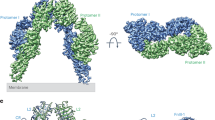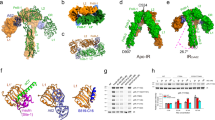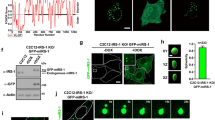Abstract
We have examined the association of insulin receptors (IR) and downstream signaling molecules with membrane microdomains in rat basophilic leukemia (RBL-2H3) cells following treatment with insulin or tris(2-pyridinecarbxylato)chromium(III) (Cr(pic)3). Single-particle tracking demonstrated that individual IR on these cells exhibited reduced lateral diffusion and increased confinement within 100 nm-scale membrane compartments after treatment with either 200 nM insulin or 10 μM Cr(pic)3. These treatments also increased the association of native IR, phosphorylated insulin receptor substrate 1 and phosphorylated AKT with detergent-resistant membrane microdomains of characteristically high buoyancy. Confocal fluorescence microscopic imaging of Di-4-ANEPPDHQ labeled RBL-2H3 cells also showed that plasma membrane lipid order decreased following treatment with Cr(pic)3 but was not altered by insulin treatment. Fluorescence correlation spectroscopy demonstrated that Cr(pic)3 did not affect IR cell-surface density or compete with insulin for available binding sites. Finally, Fourier transform infrared spectroscopy indicated that Cr(pic)3 likely associates with the lipid interface in reverse-micelle model membranes. Taken together, these results suggest that activation of IR signaling in a cellular model system by both insulin and Cr(pic)3 involves retention of IR in specialized nanometer-scale membrane microdomains but that the insulin-like effects of Cr(pic)3 are due to changes in membrane lipid order rather than to direct interactions with IR.




Similar content being viewed by others
References
Ishikawa, Y., Otsu, K., & Oshikawa, J. (2005). Caveolin; different roles for insulin signal? Cellular Signalling, 17, 1175–1182.
Nystrom, F., Chen, H., Cong, L.-N., Li, Y., & Quon, M. (1999). Caveolin-1 interacts with the insulin receptor and can differentially modulate insulin signaling in transfected Cos-7 cells and rat adipose cells. Molecular Endocrinology, 13, 2013–2024.
Kim, K.-B., Kim, B.-W., Choo, H.-J., Kwon, Y.-C., Ahn, B.-Y., Choi, J.-S., et al. (2009). Proteome analysis of adipocyte lipid rafts reveals that gC1qR plays essential roles in adipogenesis and insulin signal transduction. Proteomics, 9, 2373–2382.
Czech, M. (2000). PIP2 and PIP3: Complex roles at the cell surface. Cell, 100, 603–606.
Maffucci, T., Brancaccio, A., Piccolo, E., Stein, R. C., & Falasca, M. (2003). Insulin induces phosphatidylinositol-3-phosphate formation through TC10 activation. EMBO Journal, 22, 4178–4189.
Müller, G., Jung, C., Wied, S., Welte, S., & Frick, W. (2001). Insulin-mimetic signaling by the sulfonylurea glimepiride and phosphoinositolglycans involves distinct mechanisms for redistribution of lipid raft components. Biochemistry, 40, 14603–14620.
Yamaguchi, H., Shiraishi, M., Fukami, K., Tanabe, A., Ikeda-Matsuo, Y., Naito, Y., et al. (2009). MARCKS regulates lamellipodia formation induced by IGF-I via association with PIP2 and beta-actin at membrane microdomains. Journal of Cellular Physiology, 220, 748–755.
Baumann, C. A., Ribon, V., Kanzaki, M., Thurmond, D. C., Mora, S., Shigematsu, S., et al. (2000). CAP defines a second signalling pathway required for insulin-stimulated glucose transport. Nature, 407, 202–207.
Vincent, J. B. (2010). Chromium: Celebrating 50 years as an essential element? Dalton Transactions, 39, 3787–3794.
Anderson, R. A. (1998). Chromium, glucose intolerance and diabetes. Journal of the American College of Nutrition, 17, 548–555.
Anderson, R., Polansky, M., Bryden, N., & Canary, J. (1991). Supplemental-chromium effects on glucose, insulin, glucagon, and urinary chromium losses in subjects consuming controlled low-chromium diets. American Journal of Clinical Nutrition, 54, 909–916.
Martin, J., Wang, Z. Q., Zhang, X. H., Wachtel, D., Volaufova, J., Matthews, D. E., et al. (2006). Chromium picolinate supplementation attenuates body weight gain and increases insulin sensitivity in subjects with type 2 diabetes. Diabetes Care, 29, 1826–1832.
Yang, X., Palanichamy, K., Ontko, A. C., Rao, M. N. A., Fang, C. X., Ren, J., et al. (2005). A newly synthetic chromium complex—chromium(phenylalanine)3—improves insulin responsiveness and reduces whole body glucose tolerance. FEBS Letters, 579, 1458–1464.
Chen, G., Liu, P., Pattar, G. R., Tackett, L., Bhonagiri, P., Strawbridge, A. B., et al. (2006). Chromium activates glucose transporter 4 trafficking and enhances insulin-stimulated glucose transport in 3T3–L1 adipocytes via a cholesterol-dependent mechanism. Molecular Endocrinology, 20, 857–870.
Chen, W.-Y., Chen, C.-J., Liu, C.-H., & Mao, F. C. (2009). Chromium supplementation enhances insulin signalling in skeletal muscle of obese KK/HlJ diabetic mice. Diabetes, Obesity & Metabolism, 11, 293–303.
Pattar, G. R., Tackett, L., Liu, P., & Elmendorf, J. S. (2006). Chromium picolinate positively influences the glucose transporter system via affecting cholesterol homeostasis in adipocytes cultured under hyperglycemic diabetic conditions. Mutation Research, 610, 93–100.
Wang, Z. Q., Zhang, X. H., Russell, J. C., Hulver, M., & Cefalu, W. T. (2006). Chromium picolinate enhances skeletal muscle cellular insulin signaling in vivo in obese, insulin-resistant JCR:LA-cp rats. Journal of Nutrition, 136, 415–420.
Wang, H., Kruszewski, A., & Brautigan, D. L. (2005). Cellular chromium enhances activation of insulin receptor kinase. Biochemistry, 44, 8167–8175.
Ravina, A., Slezak, L., Mirsky, N., Bryden, N. A., & Anderson, R. A. (1999). Reversal of corticosteroid-induced diabetes mellitus with supplemental chromium. Diabetic Medicine, 16, 164–167.
Anderson, R. A., Cheng, N., Bryden, N. A., Polansky, M. M., Chi, J., & Feng, J. (1997). Elevated intakes of supplemental chromium improve glucose and insulin variables in individuals with type 2 diabetes. Diabetes, 46, 1786–1791.
Cheng, H.-H., Lai, M.-H., Hou, W.-C., & Huang, C.-L. (2004). Antioxidant effects of chromium supplementation with type 2 diabetes mellitus and euglycemic subjects. Journal of Agricultural and Food Chemistry, 52, 1385–1389.
Anderson, R. A., Polansky, M. M., Bryden, N. A., Bhathena, S. J., & Canary, J. J. (1987). Effects of supplemental chromium on patients with symptoms of reactive hypoglycemia. Metabolism, 36, 351–355.
Davis, C. M., & Vincent, J. B. (1997). Chromium oligopeptide activates insulin receptor tyrosine kinase activity. Biochemistry, 36, 4382–4385.
Peterson, R. L., Banker, K. J., Garcia, T. Y., & Works, C. F. (2008). Isolation of a novel chromium(III) binding protein from bovine liver tissue after chromium(VI) exposure. Journal of Inorganic Biochemistry, 102, 833–841.
Evans, G. W., & Bowman, T. D. (1992). Chromium picolinate increases membrane fluidity and rate of insulin internalization. Journal of Inorganic Biochemistry, 46, 243–250.
Lingwood, D., & Simons, K. (2010). Lipid rafts as a membrane-organizing principle. Science, 327, 46–50.
Evans, G. W., & Pouchnik, D. J. (1993). Composition and biological activity of chromium-pyridine carboxylate complexes. Journal of Inorganic Biochemistry, 49, 177–187.
Niemann, A., Bossek, U., Haselhorst, G., Wieghardt, K., & Nuber, B. (1996). Synthesis and characterization of six-coordinate nitrido complexes of vanadium(V), chromium(V), and manganese(V). Isolation of a dinuclear, mixed-valent mu-nitrido chromium(III)/chromium(V) species. Inorganic Chemistry, 35, 906–915.
Daumas, F., Destainville, N., Millot, C., Lopez, A., Dean, D., & Salomé, L. (2003). Confined diffusion without fences of a G protein coupled receptor as revealed by single particle tracking. Biophysical Journal, 84, 356–366.
Barisas, B. G., Smith, S. M., Liu, J., Song, J., Hagen, G. M., Pecht, I., et al. (2007). Compartmentalization of the Type I Fc epsilon receptor and MAFA on mast cell membranes. Biophysical Chemistry, 126, 209–217.
Saxton, M. J. (1997). Single-particle tracking: The distribution of diffusion coefficients. Biophysical Journal, 72, 1744–1753.
Roess, D. A., & Smith, S. M. L. (2003). Self-association and raft localization of functional luteinizing hormone receptors. Biology of Reproduction, 69, 1765–1770.
Christian, A. E., Haynes, M. P., Phillips, M. C., & Rothblat, G. H. (1997). Use of cyclodextrins for manipulating cellular cholesterol content. Journal of Lipid Research, 38, 2264–2272.
Fogarty, K., McPhee, J., Scott, E., & Van Orden, A. (2009). Probing the ionic atmosphere of single-stranded DNA using continuous flow capillary electrophoresis and fluorescence correlation spectroscopy. Analytical Chemistry, 81, 465–472.
Chiantia, S., Ries, J., & Schwille, P. (2009). Fluorescence correlation spectroscopy in membrane structure elucidation. Biochimica et Biophysica Acta, 1788, 225–233.
Ruan, Q., Chen, Y., Gratton, E., Glaser, M., & Mantulin, W. W. (2002). Cellular characterization of adenylate kinase and its isoform: Two-photon excitation fluorescence imaging and fluorescence correlation spectroscopy. Biophysical Journal, 83, 3177–3187.
Ries, J., & Schwille, P. (2008). New concepts for fluorescence correlation spectroscopy on membranes. Physical Chemistry Chemical Physics, 10, 3487–3497.
Schwille, P., Haupts, U., Maiti, S., & Webb, W. W. (1999). Molecular dynamics in living cells observed by fluorescence correlation spectroscopy with one- and two-photon excitation. Biophysical Journal, 77, 2251–2265.
Chen, Y., Munteanu, A. C., Huang, Y.-F., Phillips, J., Zhu, Z., Mavros, M., et al. (2009). Mapping receptor density on live cells by using fluorescence correlation spectroscopy. Chemistry A European Journal, 15, 5327–5336.
Singh, P., Paila, Y. D., & Chattopadhyay, A. (2007). Differential effects of cholesterol and 7-dehydrocholesterol on the ligand binding activity of the hippocampal serotonin 1A receptor: Implications in SLOS. Biochemical and Biophysical Research Communications, 358, 495–499.
Stahla, M. L., Baruah, B., James, D. M., Johnson, M. D., Levinger, N. E., & Crans, D. C. (2008). 1H NMR studies of aerosol-OT reverse micelles with alkali and magnesium counterions: Preparation and analysis of MAOTs. Langmuir, 24, 6027–6035.
Jin, L., Millard, A., Wuskell, J., Clark, H., & Loew, K. (2005). Cholesterol-enriched lipid domains can be visualized by di-4-ANEPPDHQ with linear and nonlinear optics. Biophysical Journal, 90, 2563–2575.
Jin, L., Millard, A. C., Wuskell, J. P., Dong, X., Wu, D., Clark, H. A., et al. (2006). Characterization and application of a new optical probe for membrane lipid domains. Biophysical Journal, 90, 2563–2575.
Wang, Y., Jing, G., Perry, S., Bartoli, F., & Tatic-Lucic, S. (2009). Spectral characterization of the voltage-sensitive dye di-4-ANEPPDHQ applied to probing live primary and immortalized neurons. Optics Express, 17, 984–990.
Demchenko, A. P., Mély, Y., Duportail, G., & Klymchenko, A. S. (2009). Monitoring biophysical properties of lipid membranes by environment-sensitive fluorescent probes. Biophysical Journal, 96, 3461–3470.
Owen, D. M., Lanigan, P. M. P., Dunsby, C., Munro, I., Grant, D., Neil, M. A. A., et al. (2006). Fluorescence lifetime imaging provides enhanced contrast when imaging the phase-sensitive dye di-4-ANEPPDHQ in model membranes and live cells. Biophysical Journal, 90, 80–82.
Crans, D. C., Baruah, B., Ross, A., & Levinger, N. E. (2009). Impact of confinement and interfaces on coordination chemistry: Using oxovanadate reactions and proton transfer reactions as probes in reverse micelles. Coordination Chemistry Reviews, 253, 2178–2185.
Maitra, A. (1984). Determination of size parameters of water-Aerosol OT-oil reverse micelles from their nuclear magnetic resonance data. The Journal of Physical Chemistry, 88, 5122–5125.
Crans, D. C., Trujillo, A. M., Bonetti, S., Rithner, C. D., Baruah, B., & Levinger, N. E. (2008). Penetration of negatively charged lipid interfaces by the doubly deprotonated dipicolinate. Journal of Organic Chemistry, 73, 9633–9640.
Karlsson, M., Thorn, H., Danielsson, A., Stenkula, K. G., Öst, A., Gustavsson, J., et al. (2004). Colocalization of insulin receptor and insulin receptor substrate-1 to caveolae in primary human adipocytes. European Journal of Biochemistry, 271, 2471–2479.
Nguyen, A., Mulyani, I., Levina, A., & Lay, P. A. (2008). Reactivity of chromium(III) nutritional supplements in biological media: An X-ray absorption spectroscopic study. Inorganic Chemistry, 47, 4299–4307.
Jeffcoat, A. R. (2002) [14C]-Chromium picolinate monohydrate: Disposition and metabolism in rats and mice. Technical Report RTI/64U-6855/15P, Research Triangle Institute, Research Triangle Park, NC.
Hepburn, D. D. D., & Vincent, J. B. (2002). In vivo distribution of chromium from chromium picolinate in rats and implications for the safety of the dietary supplement. Chemical Research in Toxicology, 15, 93–100.
Lugo, M. L., & Lubes, V. R. (2007). Ternary complex formation between chromium(III)-picolinic acid, chromium(III)-dipicolinic acid, and small blood serum bioligands. Journal of Chemical and Engineering Data, 52, 1217–1222.
Raja, N. S., Sankaranarayanan, K., Dhathathreyan, A., & Nair, B. U. (2011). Interaction of chromium(III) complexes with model lipid bilayers: Implications on cellular uptake. Biochimica et Biophysica Acta, 1808, 332–340.
Pilch, P. F., Thompson, P. A., & Czech, M. P. (1980). Coordinate modulation of d-glucose transport activity and bilayer fluidity in plasma membranes derived from control and insulin-treated adipocytes. Proceedings of the National Academy of Sciences of the United States of America, 77, 915–918.
Muller, S., Denet, S., Candiloros, H., Barrois, R., Wiernsperger, N., Donner, M., et al. (1997). Action of metformin on erythrocyte membrane fluidity in vitro and in vivo. European Journal of Pharmacology, 337, 103–110.
Freisleben, H.-J., Ruckert, S., Wiernsperger, N., & Zimmer, G. (1992). The effects of glucose, insulin and metformin on the order parameters of isolated red cell membranes: An electron paramagnetic resonance spectroscopic study. Biochemical Pharmacology, 43, 1185–1194.
Matthaei, S., Hamann, A., Klein, H. H., Benecke, H., Kreymann, G., Flier, J. S., et al. (1991). Association of metformin’s effect to increase insulin-stimulated glucose transport with potentiation of insulin-induced translocation of glucose transporters from intracellular pool to plasma membrane in rat adipocytes. Diabetes, 40, 850–857.
Hundal, H., Ramlal, T., Reyes, R., Leiter, L., & Klip, A. (1992). Cellular mechanism of metformin action involves glucose transporter translocation from an intracellular pool to the plasma membrane in L6 muscle cells. Endocrinology, 131, 1165–1173.
Pike, L. J., & Miller, J. M. (1998). Cholesterol depletion delocalizes phosphatidylinositol bisphosphate and inhibits hormone-stimulated phosphatidylinositol turnover. Journal of Biological Chemistry, 273, 22298–22304.
Huby, R. D., Dearman, R. J., & Kimber, I. (1999). Intracellular phosphotyrosine induction by major histocompatibility complex class II requires co-aggregation with membrane rafts. Journal of Biological Chemistry, 274, 22591–22596.
Sheets, E., Holowka, D., & Baird, B. (1999). Membrane organization in immunoglobulin E receptor signaling. Current Opinion in Chemical Biology, 3, 95–99.
Reis-Sobreiro, M., Gajate, C., & Mollinedo, F. (2009). Involvement of mitochondria and recruitment of Fas/CD95 signaling in lipid rafts in resveratrol-mediated antimyeloma and antileukemia actions. Oncogene, 28, 3221–3234.
Janes, P., Ley, S., & Magee, A. (1999). Aggregation of lipid rafts accompanies signaling via the T cell antigen receptor. Journal of Cell Biology, 147, 447–461.
Acknowledgments
This study was supported by the NSF (CHE0628260, MCB1024668) and by the American Heart Association (AHA0650081Z).
Author information
Authors and Affiliations
Corresponding author
Additional information
Abeer Al-Qatati and Peter W. Winter were contributed equally to this study.
Rights and permissions
About this article
Cite this article
Al-Qatati, A., Winter, P.W., Wolf-Ringwall, A.L. et al. Insulin Receptors and Downstream Substrates Associate with Membrane Microdomains after Treatment with Insulin or Chromium(III) Picolinate. Cell Biochem Biophys 62, 441–450 (2012). https://doi.org/10.1007/s12013-011-9326-x
Published:
Issue Date:
DOI: https://doi.org/10.1007/s12013-011-9326-x




